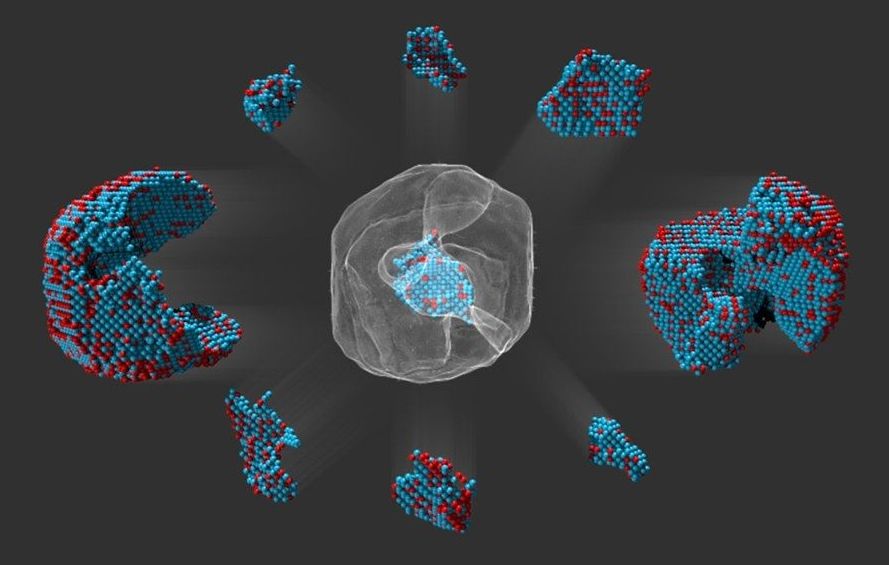Archive for the ‘quantum physics’ category: Page 680
Sep 26, 2018
The Physics of Information: Quantum Potentiality to Classical Actuality of Your Experiential Reality
Posted by Alex Vikoulov in categories: computing, mathematics, neuroscience, quantum physics
Physicists face the same hard problem as neuroscientists do: the problem of bridging objective description and subjective experience. Physics has encountered consciousness. Quantum theory says an object remains in a superposition of possibilities until observed. We can consider a quantum state as being about our knowledge rather than a direct description of physical reality. The physics of information just may be that bridging of quantum-to-digital reality of subjective experience. We are now at the historic juncture when quantum computing could reveal quantum information processing underpinnings of subjectivity. Quantum mechanics is a spectacularly successful theory of fundamental physics that allows us to make probabilistic predictions derived from its mathematical formalism, but the theory doesn’t tell us precisely how these probabilities should be interpreted in regards to phenomenology, i.e. our experiential reality. There are basically three main interpretive camps within quantum mechanics from which stem at least a dozen further interpretations.
By Alex Vikoulov.
Sep 24, 2018
Key companies to attend White House quantum computing meeting
Posted by Genevieve Klien in categories: computing, government, quantum physics
WASHINGTON (Reuters) — The White House will hold a meeting on Monday on U.S. government efforts to boost quantum information science, with administration officials, leading companies including Alphabet Inc ( GOOGL.O ), IBM Corp ( IBM.N ), JPMorgan Chase & Co ( JPM.N ) and academic experts taking part.
Sep 24, 2018
A new way to count qubits
Posted by Genevieve Klien in categories: computing, quantum physics
Researchers at Syracuse University, working with collaborators at the University of Wisconsin (UW)-Madison, have developed a new technique for measuring the state of quantum bits, or qubits, in a quantum computer.
Their findings are the subject of an article in Science magazine, which elaborates on the experimental efforts involved with creating such a technique.
The Plourde Group—led by Britton Plourde, professor of physics in Syracuse’s College of Arts and Sciences (A&S)—specializes in the fabrication of superconducting devices and their measurement at low temperatures.
Sep 23, 2018
Google, JPMorgan Chase & Co, IBM, Other Key Companies To Attend White House Quantum Computing Meeting
Posted by Genevieve Klien in categories: quantum physics, robotics/AI, transportation
Quantum computing ‘will enable us to predict and improve chemical reactions, new materials and their properties, as well as provide new understandings of spacetime and the emergence of our universe,’ the White House said.
Google, IBM, JPMorgan Chase & Co., and other key U.S. companies are set to attend a White House quantum computing meeting to be held on Monday, Reuters reports.
A groundbreaking technology still in its infancy, quantum computing could have a major impact on transportation, healthcare, communications, weather forecasting, artificial intelligence, and other areas. Quantum computing could, experts claim, revolutionize our society.
Sep 21, 2018
What Will Quantum Computer Games Be Like?
Posted by Klaus Baldauf in categories: computing, entertainment, quantum physics
You’ve just booted up a game on a state-of-the-art quantum computer. You’re running 19 superconducting quantum bits on a processor held at near absolute zero. Anticipating its sheer power, you press start and…
Sep 21, 2018
New Microscope Shows the Quantum World in Crazy Detail
Posted by Genevieve Klien in categories: biotech/medical, quantum physics
The transmission electron microscope was designed to break records. Using its beam of electrons, scientists have glimpsed many types of viruses for the first time. They’ve used it to study parts of biological cells like ribosomes and mitochondria. You can see individual atoms with it.
But experts have recently unlocked new potential for the machine. “It’s been a very dramatic and sudden shift,” says physicist David Muller of Cornell University. “It was a little bit like everyone was flying biplanes, and all of a sudden, here’s a jetliner.”
You’ve read your last complimentary article this month. To read the full article, SUBSCRIBE NOW. If you’re already a subscriber, please sign in and and verify your subscription.
Continue reading “New Microscope Shows the Quantum World in Crazy Detail” »
Sep 21, 2018
New observations to understand the phase transition in quantum chromodynamics
Posted by Genevieve Klien in categories: cosmology, particle physics, quantum physics
The building blocks of matter in our universe were formed in the first 10 microseconds of its existence, according to the currently accepted scientific picture. After the Big Bang about 13.7 billion years ago, matter consisted mainly of quarks and gluons, two types of elementary particles whose interactions are governed by quantum chromodynamics (QCD), the theory of strong interaction. In the early universe, these particles moved nearly freely in a quark-gluon plasma. Then, in a phase transition, they combined and formed hadrons, among them the building blocks of atomic nuclei, protons and neutrons.
In the current issue of Nature, an international team of scientists has presented an analysis of a series of experiments at major particle accelerators that sheds light on the nature of this transition. The scientists determined with precision the transition temperature and obtained new insights into the mechanism of cooling and freeze-out of the quark-gluon plasma into the current constituents of matter such as protons, neutrons and atomic nuclei. The team of researchers consists of scientists from the GSI Helmholtzzentrum für Schwerionenforschung in Darmstadt, and from the universities of Heidelberg and Münster (Germany), and Wroclaw (Poland).
A central result: The record-breaking high-energy experiments with the ALICE detector at the Large Hadron Collider (LHC) at the research center CERN produced matter in which particles and antiparticles coexisted in equal amounts, similar to the conditions in the early universe. The team has confirmed via analysis of the experimental data theoretical predictions that the phase transition between quark-gluon plasma and hadronic matter takes place at the temperature of 156 MeV, 120,000 times higher than that in the interior of the sun.
Continue reading “New observations to understand the phase transition in quantum chromodynamics” »
Sep 19, 2018
For Tiny Light Particles, ‘Before’ and ‘After’ Mean Nothing
Posted by Genevieve Klien in categories: particle physics, quantum physics
Sep 18, 2018
Modified superconductor synapse reveals exotic electron behavior
Posted by Genevieve Klien in categories: business, particle physics, quantum physics
Electrons tend to avoid one another as they go about their business carrying current. But certain devices, cooled to near zero temperature, can coax these loner particles out of their shells. In extreme cases, electrons will interact in unusual ways, causing strange quantum entities to emerge.


















